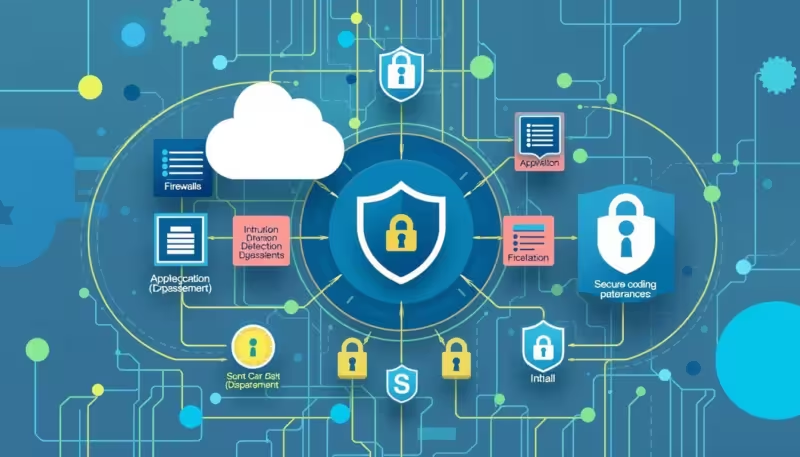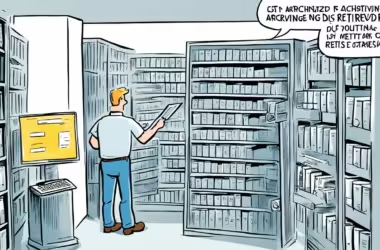In this digital age, keeping software safe is crucial. Data breaches and cyberattacks are on the rise. A solid Software Security Architecture helps protect apps and builds trust.
It consists of risk assessments, ongoing training, and encryption. Also, it must work well with the development process, as IBM suggests. Adding Cybersecurity Best Practices means creating safer applications from the beginning.
This guide will cover strategies that meet industry standards. We aim to help you strengthen your applications’ security.
Understanding Software Security Architecture
Software Security Architecture is a key framework that keeps applications safe from many security threats and weaknesses. It focuses on protecting sensitive information and blocking unauthorized users. This is key for software today, as it faces more complex challenges than ever.
Definition and Importance
The impact of security architecture is huge. A strong architecture can prevent 80% of security problems. This protects data and keeps user trust high. It uses strong encryption, good authentication methods, and thorough checks to fight against attacks.
Key Objectives of Security Architecture
Setting clear security goals is crucial for a solid security system. Goals often include:
- Recognizing security needs early in software creation.
- Choosing and using security controls that match business aims.
- Making sure security is part of every software development step.
By using smart design patterns, firms can cut down on security gaps by 60%. Regular checks can also reduce security issues by 70%. These steps show that security architecture is more than just a must-follow rule. It’s a key advantage in a world full of risks.
The Role of Security in Software Development Lifecycle (SDLC)
It’s vital to integrate security measures during the Software Development Lifecycle. This makes applications strong and safe. By focusing on security from planning to deployment, we catch issues early. This helps protect sensitive information and makes the software better.
Integration of Security in Different Stages
Security is key in each SDLC phase. Teams use methods like waterfall, agile, and DevSecOps for smooth security checks. Every development step must include security evaluations to find and lessen risks:
- Planning: Conducting risk assessments and security awareness training.
- Design: Implementing secure design principles and threat modeling.
- Coding: Adopting secure coding practices and performing code reviews.
- Testing: Applying dynamic and static analysis to reveal vulnerabilities.
- Deployment: Ensuring secure configurations and access controls.
Benefits of a Secure Development Process
Secure development comes with many advantages. When security is part of the SDLC, companies benefit from:
- Early spotting of vulnerabilities, which cuts down on fixing costs.
- Better compliance with rules to avoid legal problems.
- Higher trust from users, lowering risks of money loss from data leaks.
- Better defense against cyber attacks on software flaws.
- More trust in software’s performance, especially important for finance and healthcare.
Using these methods protects user info and strengthens a company’s standing in the market. It keeps security as a top focus in the evolving Software Development Lifecycle.
Key Components of Application Security Architecture
The success of application security architecture depends on key parts working together. These include Data Protection mechanisms, safe interfaces, and strong system security. These create a solid defense. Knowing about these components helps keep data safe and ensures secure messages.
Data Protection Mechanisms
To protect data, we use Data Protection strategies. Companies use many ways to keep data safe, like:
- Encryption: Changing data to a form that unauthorized users can’t read.
- Access Controls: Only letting certain people access data.
- Data Masking: Changing sensitive info so it’s hidden.
These Application Security Components lower risks and keep data safe during the app’s life.
Secure Interfaces and Communication Protocols
Keeping communication safe stops unauthorized access and leaks. Using Secure Communication Protocols helps. It makes sure info stays private and unchanged when systems talk to each other. Methods include:
- Transport Layer Security (TLS): Keeps data safe while it’s sent.
- API Security Standards: Makes sure APIs are used safely.
By setting these protocols, we make communication channels stronger against attacks.
System-Level Security Measures
There’s more to security than encryption and controlling access. Organizations use system-level security to improve safety. This includes:
- Firewalls: Checks network traffic and stops bad activities.
- Intrusion Detection Systems (IDS): Finds possible security issues.
- Secure Coding Practices: Uses rules to avoid problems during development.
Together, these measures are a key defense against threats. They help build a full security plan for applications.
Benefits of Implementing Robust Security Architecture
Having a strong security architecture helps businesses a lot in the digital world. It supports a company’s cybersecurity efforts and defends against more and frequent cyber attacks.
Enhanced Monitoring Capabilities
The benefits of security architecture include better monitoring. With it, companies can spot and act on suspicious activities fast. This quick response helps lessen any harm.
Proactive Threat Mitigation
A good security setup also means being ahead of threats. It lets organizations stop risks before they become bigger problems. This keeps information safe and makes a security-minded culture.
Regulatory Compliance and Risk Management
Strong security architecture means meeting important rules too. For example, healthcare must follow HIPAA, and European companies must stick to GDPR. This helps manage risks and keeps a business’s good name. Being compliant builds trust with customers and helps reach business goals.
Best Practices for Application Security Architecture
It’s crucial to follow top security methods in our complex digital world. Firms must do regular security checks and assessments. This helps find weak spots and meets industry rules. Being proactive about security keeps applications safe and ready to face new threats.
Continuous Security Audits and Assessments
Regular security checks are fundamental. They let firms closely examine their apps to fix weak points early. The expected global cost of cybercrime is $10.5 trillion by 2025. This fact highlights the need for continuous assessments. Important assessment activities include:
- Conducting vulnerability assessments to pinpoint security weaknesses.
- Reviewing compliance with industry standards like HIPAA and PCI DSS to avoid hefty fines.
- Implementing findings from audits to enhance security measures.
Incorporating Secure Coding Practices
Using secure coding practices is key in protecting apps. Practices such as input checks, code reviews, and trusted libraries matter a lot. OWASP offers guidelines for developers to secure their apps effectively. Vital practices cover:
- Ensuring robust input validation to prevent issues like SQL injection.
- Leveraging proper error handling and logging to protect against information leakages.
- Implementing multi-factor authentication to bolster access control and user identity verification.
Building a security-aware culture among development teams boosts Secure Coding Practices. This shift enhances security throughout the entire company.
Common Challenges in Application Security
Organizations face many challenges in keeping applications safe. Cyber threats are changing fast, making it hard to spot weaknesses. With more cases of data theft and cloud breaches, a forward-thinking security plan is crucial. It helps protect important data from hidden threats.
Identifying Network Vulnerabilities
Finding network weaknesses is a big challenge for many groups. The rise of certain security risks puts data at risk. The 2021 OWASP Top 10 Report highlights the need to tackle these issues.
Experts suggest using tools like Web Application Firewalls (WAFs) for protection. Also, checking for threats carefully can reveal specific flaws in the system.
Addressing Architectural Complexities
Security systems can be complex, making it hard to keep software safe. Balancing security tools, rules, and advanced designs requires a detailed plan. Using a defense-in-depth strategy can add multiple security layers. This helps protect against the complex challenges of today’s apps.
It’s also key to educate employees and stick to the Principle of Least Privilege (POLP). This can reduce mistakes that lead to security issues.
Risk Assessment and Threat Modeling
In today’s fast-changing digital world, knowing the weak spots in applications is key. By carrying out detailed risk assessments, organizations can spot and measure their vulnerabilities. This proactive step helps businesses focus their security efforts where they are most needed. It considers how likely dangers are and their possible effects on operations.
Understanding Potential Vulnerabilities
Risk assessment is vital for keeping security strong in companies. It understands that risks vary from one organization to another. Custom risk assessments are, therefore, essential. Frameworks like the NIST Risk Management Framework and ISO/IEC 27005:2022 give advice on doing detailed assessments. These should happen regularly to keep up with new threats and changes in IT systems.
Vulnerabilities make systems open to many dangers, raising the overall risk. A deep risk analysis looks into how assets might be affected and the harm they could face. This analysis leads to evaluating risks and deciding on plans to address them. By pinpointing assets and business goals, companies can better understand their weak points and threats.
Creating Effective Mitigation Strategies
Concentrating on threat modeling lets organizations develop specific plans to lessen risks. This begins by defining the assets and spotting potential threats, including attacker tactics. Knowing the vulnerabilities is crucial in coming up with actions to reduce risk. Approaches from NIST and Microsoft, like STRIDE, provide structured methods for threat modeling.
Threat modeling involves certain steps: identifying threats, ranking them, and noting down vulnerabilities and actions against them. This focused effort usually happens when designing or updating systems or applications. As systems evolve, it’s important to integrate security measures to stay ahead of new threats.
Risk assessment and threat modeling complement each other, helping organizations guard against big risks efficiently. While threat modeling looks closely at specific threats and vulnerabilities, risk assessment considers the wider risks and goals of an organization. Together, they lead to the creation of targeted strategies to fight the vulnerabilities found.
Integration with Development Process
Adding security right from the start of development is key to creating a responsible and efficient culture. It allows teams to find and fix problems early on. This is vital for setting up strong security while keeping work flowing smoothly.
DevSecOps Approach
The DevSecOps method makes sure security is part of the whole development cycle. It makes everyone responsible for security. Through automated tests in CI and CD pipelines, teams boost their security levels.
Studies show that DevSecOps speeds up finding and fixing security issues. It’s now widely accepted for improving security culture. Training and tools from groups like OWASP are key parts of DevSecOps.
Container Security Considerations
Container security is crucial when integrating with development processes. It’s important to keep containers secure, check for vulnerabilities, and watch for unauthorized access. As more businesses use containers, knowing how to keep them safe is necessary. This ensures a secure setup for deploying applications.
Tools and Technologies for Security in Software
Today’s organizations face growing threats, making strong security tools crucial. Implementing solid Software Security Solutions is key to protect apps. It also keeps sensitive data safe. By using advanced security tools and constant monitoring, companies can improve their defense.
Utilizing Advanced Security Tools and Solutions
Advanced security tools are vital for fighting vulnerabilities. 84 percent of software breaches happen at the application layer. This fact proves security tools are essential. Tools like Nessus Professional help find weak spots in software and IT devices. Metasploit is also popular for checking how strong a network’s defense is.
- Security tools such as Kali Linux offer over 500 pre-installed tools aimed at information security tasks, like scanning networks for weak points.
- Network security tools can analyze data in real-time. Many also look back at past data to help companies make better decisions.
Continuous Monitoring and Real-World Testing
Keeping an eye on systems at all times helps companies react quickly to threats. Many organizations reduce risks of business and financial loss with real-time alerts from security solutions. Regular tests in real-world conditions keep security strategies sharp and ready for new challenges.
Tools like Nessus show how often vulnerabilities appear, underlining the need for thorough scans. Tools like Snort are key in spotting network breaches fast. This helps strengthen cybersecurity. In today’s digital world, using these Security Tools is a top strategy for ensuring strong software security.
Conclusion
The importance of Software Security Architecture is huge in today’s digital world. Companies are using more applications in their work, making a solid Application Security Summary essential. By focusing on being proactive with security, they can cut down on risks and keep sensitive data safe from hackers.
Looking at different security parts and best practices shows that a detailed approach improves how things run. The power of Security Architecture Impact is that it strengthens defense. It also helps companies keep up with rules they need to follow. As firms change and cyber dangers become more complex, adding security in all steps of development is key to protecting what’s important.
Wrapping up, the need for ongoing updates and changes in security is clear. By making security a main focus in app design and making, businesses not only meet rules but also gain their customers’ trust. This leads to a strong and safe digital environment in the future.






